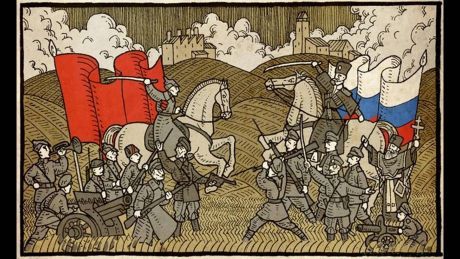Features
You are here
1917: how the revolution was lost

October 23, 2017
There should be no doubt that the Russian Revolution was lost. It was overturned by the Stalinist counter revolution in the late 1920s and into the 1930s. Much had been lost before this point, but during these years a new ruling class extinguished all vestiges of democracy and human liberation.
This new ruling class was the government apparatus and their representative was Stalin—who eliminated both the gains of the revolution and the revolutionaries themselves. The historian Tamara Deutscher wrote, “Nearly all the leaders of the October revolution, all members of Lenin’s Politbureau, most commanders of the Red Army, many outstanding scientists and writers were denounced as terrorists, murderers, and wreckers, as foreign spies and traitors and executed.”
Counter-revolution
The October revolution occurred in a country ravaged by World War One and about to be ravaged by five more years of civil war. The foes of democracy and progress within Russia were supported and supplied by the world’s great powers. This included blockades to keep out food and medicine and an invasion by 14 countries including Canada, involving over 200,000 foreign troops. The great powers also provided money and guns to the forces attempting to reinstate the rule of the Czars. The war and collapse of industry lead to famine and disease. Seven million died of disease, the same number as Russian soldiers killed in World War One. The destruction of industry and trade lead to major cities reduced to a small fraction of their former population. The working class largely ceased to exist. In these circumstance, we shouldn’t be surprised that the initial success and gains of the revolution were crushed. What is surprising is that so much was accomplished in so little time and in such terrible circumstances.
The Bolsheviks found themselves running a worker’s state where the working class had largely disappeared. The collapse of industry meant it was nearly impossible to raise living standards, and their was no way to trade for the food produced by the peasantry. Armed workers confiscating the harvest to try to feed those starving in the cites didn’t look a lot different to the peasants than the old aristocratic landlords demanding tribute. The peasants had gone from being allies in the creation of a better world to opponents of the new regime.
The new state had no choice but to implement more and more authoritarian methods, just to try to keep people fed, to defend itself from the forces of counter revolution, and to try to slow the collapse of industry. One by one the other socialist parties in Russia went from opposing workers’ democracy to allying themselves with forces to their right and effectively became supporters of a bloody restoration of the aristocracy.
Stalin
During the civil war communist party members were tortured to death when captured by the white army. After the civil war membership became a ticket to a job in the civil service. In this situation where people in the ranks of the government administration were no longer part of a flourishing workers’ democracy and some began to work in their own interests. Stalin became the representative of these sorts of people. However they couldn’t completely complete their control without a counter-revolution and all the blood and terror that that requires.
The prison populations grew enormously. The number of forced labourers in the Gulags grew by a factor of of nearly 100 in the decade following 1927. From 140,000 prisoners to over 11 million. Stalin’s state police arrested and killed more communists then perished in the long years of underground operation, during the revolution, and the civil war, combined. Even loyal Stalinist were not safe. Of the nearly 2000 delegates to the 1934 Communist Party Congress (who were all loyal to Stalin) well over half were executed over the next few years.
This monstrous new regime cloaked itself in the words and symbols of the victorious workers’ and peasants’ revolution that it had destroyed and the ruling classes elsewhere were happy to go along with this pretense. However, the truth of the October revolution still inspires people to today, and we have a duty to make sure that the truth is told.
This is the third in a four part series of articles commemorating the 100th anniversary of the Russian Revolution. The next articles will look at the gains of the revolution, how the revolution was lost, and lessons for socialists today.
Join the events “Ten Days That Shook the World”, Wednesday October 25 in Vancouver, Toronto and Ottawa
Section:










